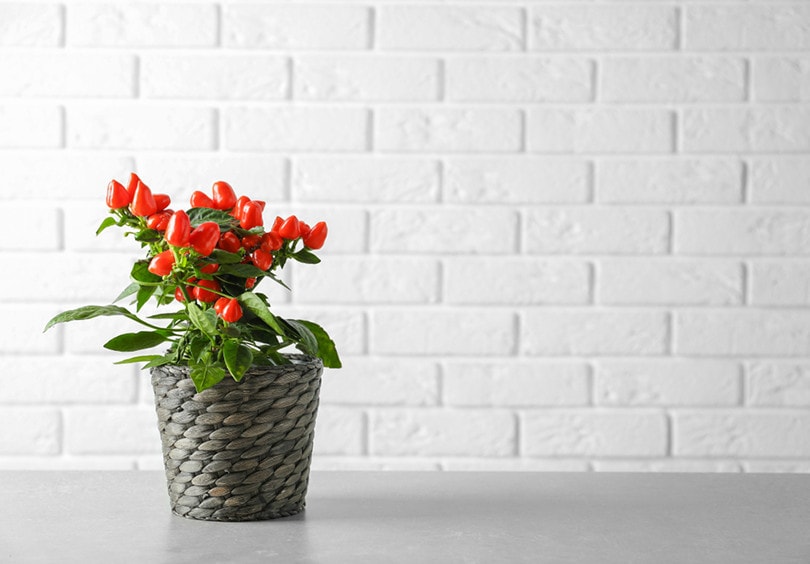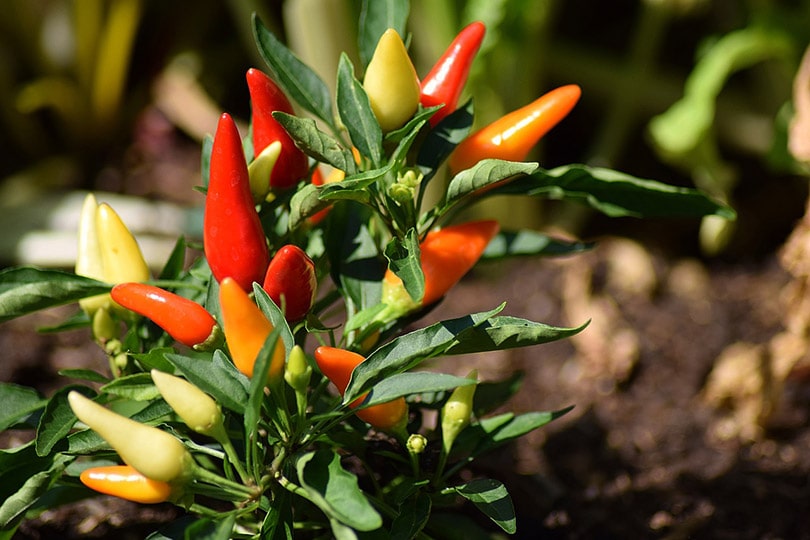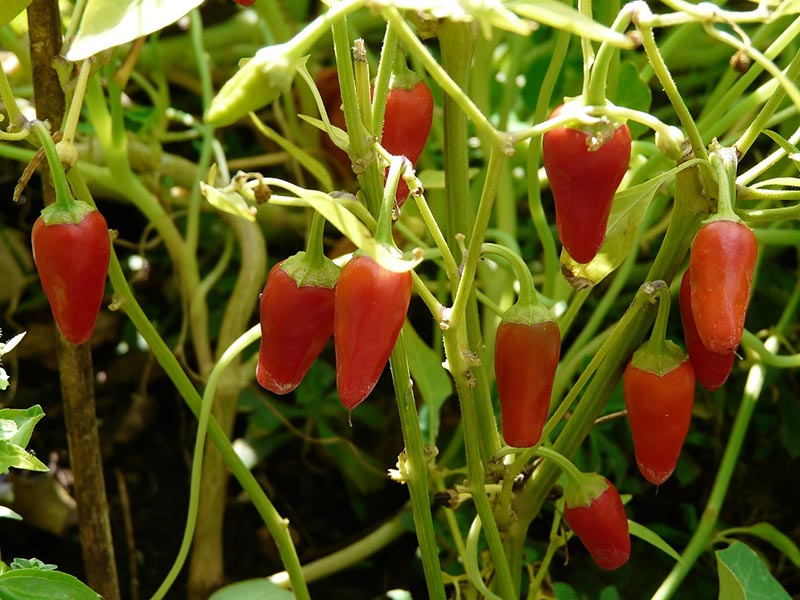Can You Grow Peppers Indoors? Tips, Tricks & How-To Guide
-
Codee Chessher
- Last updated:

Peppers grown indoors will never be as large as ones grown outdoors, due to space restrictions, but they’ll taste exactly the same. If you want to grow peppers but don’t have any suitable outdoor space, why not try to grow them indoors? With some basic planning and equipment, you can have sweet or hot peppers at any time of the year. Let’s find out exactly what you need and how to do it.
Before You Start
Peppers have three basic needs: water, sunlight, and nutrients. This guide will be using soil, as growing peppers with hydroponic solutions has drastically different steps.
Preferably you will have a southern-facing window, as this will be perfect for getting your plant the right amount of sunlight. If your area doesn’t get enough natural sunlight, you can opt to hang a grow light above your plant, but this might raise your electric bill by a noticeable amount. You can also use a grow light to supplement whatever natural light you can give your plant.
Next, you’ll need to decide what type of pepper you want to grow, because plants vary widely in size. You have several you can choose from that will do well indoors, and most are varieties you commonly see in the produce section at your local grocery store.

Good peppers for indoor growing include:
- Habaneros
- Jalapenos
- Banana peppers
- Thai peppers
- Serrano peppers
A pot with a diameter of 12 inches should be sufficient for your needs, but you can use a smaller container to start your seeds and get them sprouting. It’s also okay to just use the big pot as a forever container, and in fact, it will cut down on the chances of transplant shock. Soil quality is important, and we’d recommend you use high-quality potting soil to fill the pot.
Pepper plants need several nutrients to grow, including nitrogen. As the plant matures, though, it will need other nutrients like potassium, calcium, and phosphorus. Without them, your plant might have difficulty producing fruit. If you fertilize your plant, consider switching to a low-nitrogen brand of fertilizer once it reaches maturity.
Finally, pepper plants require 70–80-degree (F) ambient temperatures. During the day, they like heat, while as cool as 70 degrees F is fine at night. Ambient humidity should be between 60%-80%, but you can use a humidifier if you’d like. If this is a little too warm for your taste, you can use heating pads or grow mats to keep the plants warm instead of using your A/C system.

You Will Need:
- Pepper seeds
- Potting soil
- Pot (at least one)
- Sunlight and/or grow light (6-8 hours per day)
- Fertilizer (optional but recommended)
- Stakes
- Fan
- Water
- Paper towels
How to Grow Peppers Indoors – 5 Easy Steps
1. Start Your Seeds
You can use grow trays to start your seeds if you’d prefer, but we’d suggest you just save the time and start your seeds in your ‘forever’ pot. Sow your seeds a quarter-inch under the soil’s surface and thoroughly water the plant. The soil should be saturated but not flooded; at most, you should see bare trickles running out of the bottom of the pot.
Now you wait until the soil is completely dry before watering again, which should take several days or so. Until the seed sprouts, it doesn’t need light, so don’t worry about sun exposure or grow lights right now. Simply keep the soil in the pot moist until the seed sprouts, which can take 2-4 weeks.

2. Continue to Nurture Your Plant
Once your seed sprouts, it starts needing regular light exposure via the sun or grow lights. At this stage, 6 to 8 hours of light is enough. Later on, it will need more to produce fruit. Continue to regularly water the plant once the soil dries out, remaining vigilant that it doesn’t dry out or flood.
You should begin running a fan in the same room as your plants so they’re adequately aerated. Plants need fresh oxygen to thrive, and simply having air circulation in the vicinity will help a lot. Lack of aeration can produce plant edema, which is where the plant absorbs too much moisture.
You can apply most fertilizers weekly, and instructions vary based on the type of product (powder, spray, etc.). Be sure to read your documentation closely, as some high-strength fertilizers only need to be applied every few months. Excessive application of these products can scorch your plant.
3. Stake Your Plant
Staking a pepper plant will give it something to wrap around as it grows, providing the plant structural stability. Some people prefer to plant the stake early on, so it doesn’t disturb the roots, it doesn’t matter very much when you do it. Plant the stake right next to the stem of your pepper plant, then use some twine to loosely tie the stem and branches to the stake.

4. Prepare For Fruiting
The exact timing depends on the type of pepper you’re growing, but most peppers can produce fruit between 3-4 months after sprouting. Using a smaller container can force the plant to fruit early, though the peppers grown will be rather small.
High nitrogen encourages plants to grow more leaves, so you should switch to a low-nitrogen fertilizer once your pepper plant begins growing flowers.
Most critically, you need to be giving your plant as much light as possible. Twelve hours of sunlight is a good number, but closer to 14 or 16 hours is better if you can manage it. Natural light isn’t always possible due to our climates, but that’s where a grow light really comes in handy.
5. Harvest Your Peppers!
Unlike other fruit that should be left on the plant to ripen, you should pick peppers as soon as they reach the color you want. Habaneros, for example, will be bright orange when they are ready to be picked, but you can wait until they turn redder if you like extra spicy peppers.
Jalapeno peppers turn from light green to deep green, then start turning red. Most jalapenos are picked when they’re green, but red jalapenos are great too. The main difference is that the red ones are both spicy and sweet, while the green are mostly just spicy.
Pepper Growing Tips & Tricks
There are lots of tips you can make use of to enhance your gardening experience. Your first pepper-growing experience might not end perfectly, but with practice and experience, you’ll be growing peppers with ease. Let’s go over some tips to help make your growing easier.

Pepper Growing Tips:
- If you grow indoors and outdoors, bringing mature pepper plants indoors can give you a huge head start on the next season. You may even be able to get them to produce some fruit during the winter if you can provide the right conditions.
- Adequate drainage makes all the difference for plants, and peppers especially, because their long grow time makes them susceptible to root rot. Whatever isn’t absorbed into the soil should be draining out of the pot.
- Adding mulch around the base of your plant can help it retain heat and moisture, especially if it’s a little cool in the house.
- When harvesting peppers, always use scissors or pruners to cut the peppers on the stem, leaving a bit of stem behind. Cutting off the stem entirely can damage the plant.
- You can harvest peppers at any time, but letting them ripen will improve flavor, spice levels, and nutritional content.
 In Conclusion
In Conclusion
Peppers are one of the tastiest ways to add some color and spice to a dish. Although they may take a while to grow, it’s perfectly possible to grow peppers indoors year-round if you can replicate its ideal conditions. With some basic equipment and patience, you too can have peppers for next year!
Featured Image Credit: New Africa, Shutterstock
Contents

